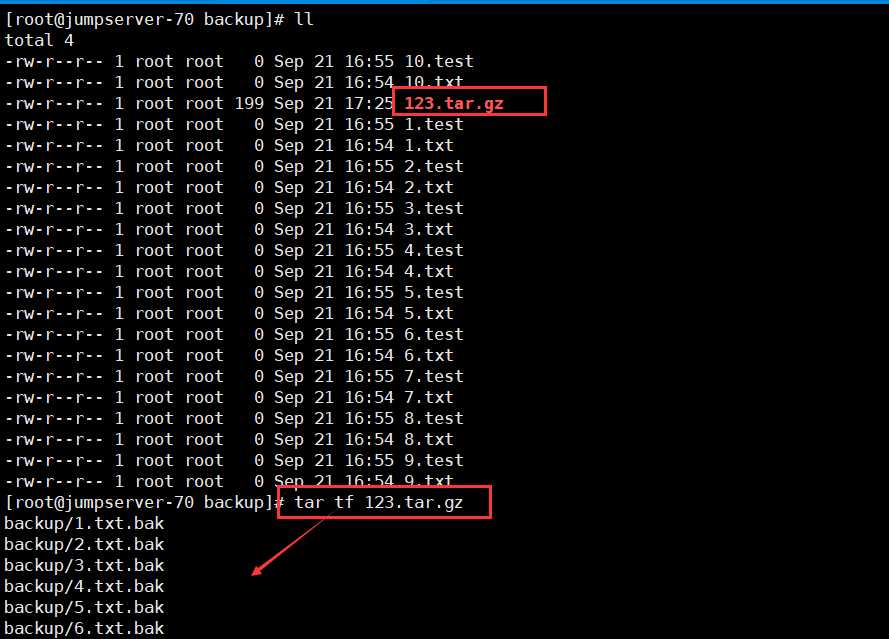标签:use 习题 ddc 随机 修改 名称 ret res col
描述:
写一个猜数字脚本,当用户输入的数字和预设数字(随机生成一个0-100的数字)一样时,直接退出,否则让用户一直输入:并且提示用户输入的数字比预设数字大或者小
分析:
1:随机数字是如何生成的
2:这是一个死循环,直到猜对了才能退出
3:需要判断大小
脚本实现:
[root@jumpserver-70 scripts]# cat num_random.sh #!/bin/bash num=$(echo $(($RANDOM%100+1))) i=0 while true do read -p "请猜一下这个数是多少:" number let i++ if [[ ! $number =~ ^[0-9]+$ ]];then echo "请检查输入的是否为数字" elif [ $number -gt $num ];then echo "你输入的数大了!" elif [ $number -lt $num ];then echo "你输入的数小了- -" else echo "恭喜你!都会抢答了。" echo "你一共猜了 $i 次" exit 1 fi done
实现的效果:
[root@jumpserver-70 scripts]# sh num_random.sh 请猜一下这个数是多少:10 你输入的数小了- - 请猜一下这个数是多少:50 你输入的数小了- - 请猜一下这个数是多少:90 你输入的数大了! 请猜一下这个数是多少:80 你输入的数小了- - 请猜一下这个数是多少:85 你输入的数大了! 请猜一下这个数是多少:83 你输入的数小了- - 请猜一下这个数是多少:84 恭喜你!都会抢答了。 你一共猜了 7 次
描述:
请写出:使用for循环在/opt目录下通过随机小写10个字母加固定字符串test批量创建10个html文件,创建完成后,讲test全部改为test_done(for循环实现),并html为大写HTML
分析:
1:随机是个小写字母 file=$(uuidgen | sed -r ‘s#[0-9-]+##g‘|cut -c 1-10)
2:创建的文件名字放到一个文件中,再取出文件名
3:用mv改名用替换方式
脚本实现:
[root@jumpserver-70 scripts]# cat make_file.sh #!/bin/bash for i in {1..10} do file=$(uuidgen | sed -r ‘s#[0-9-]+##g‘|cut -c 1-10) [ -f test_$file.html ] if [ $? -eq 0 ];then echo "这个文件已经存在。。" else touch /opt/test_${file}.html &>/dev/null echo test_${file}.html >>/opt/test1.txt echo "你已经创建了 test_$file.html 文件" fi done echo "------------正在执行操作------------" for n in {1..10} do name=$(sed -rn ${n}p /opt/test1.txt | sed -r ‘s#.*_(.*).html#\1#g‘) name_new=test_done_${name}.HTML mv /opt/test_${name}.html /opt/$name_new echo "文件 $name_new 修改成功" done > /opt/test1.txt
第二种方法:
[root@web03 ~]# cat for_file2.sh #!/bin/bash #1.循环创建10个随机文件名的html文件 for i in {1..10} do File_Name=$(openssl rand -base64 40 |sed ‘s#[^a-z]##g‘|cut -c1-10) touch test_${File_Name}.html done #2.查找当前目录下.html结尾的文件,写入一个文件中 find ./ -type f -name "*.html" > 3.txt for i in $(cat 3.txt) do #4.将带html修改为HTML ${i/html/HTML} 将文件名后缀是html替换为HTML mv $i ${i/html/HTML} done
实现效果:
[root@jumpserver-70 scripts]# sh make_file.sh 你已经创建了 test_fababba.html 文件 你已经创建了 test_cdedacafaf.html 文件 你已经创建了 test_eedbacbafc.html 文件 你已经创建了 test_adbfdeb.html 文件 你已经创建了 test_afdddcdebe.html 文件 你已经创建了 test_bacfaeeacf.html 文件 你已经创建了 test_bcfadfbcdd.html 文件 你已经创建了 test_faeebfcdc.html 文件 你已经创建了 test_eebecffac.html 文件 你已经创建了 test_eefca.html 文件 ------------正在执行操作------------ 文件 test_done_fababba.HTML 修改成功 文件 test_done_cdedacafaf.HTML 修改成功 文件 test_done_eedbacbafc.HTML 修改成功 文件 test_done_adbfdeb.HTML 修改成功 文件 test_done_afdddcdebe.HTML 修改成功 文件 test_done_bacfaeeacf.HTML 修改成功 文件 test_done_bcfadfbcdd.HTML 修改成功 文件 test_done_faeebfcdc.HTML 修改成功 文件 test_done_eebecffac.HTML 修改成功 文件 test_done_eefca.HTML 修改成功 [root@jumpserver-70 opt]# ll total 0 -rw-r--r-- 1 root root 0 Sep 20 21:00 test1.txt -rw-r--r-- 1 root root 0 Sep 20 21:00 test_done_aadacfbdea.HTML -rw-r--r-- 1 root root 0 Sep 20 21:00 test_done_badbcedabf.HTML -rw-r--r-- 1 root root 0 Sep 20 21:00 test_done_ccdbddfaff.HTML -rw-r--r-- 1 root root 0 Sep 20 21:00 test_done_daafffacfb.HTML -rw-r--r-- 1 root root 0 Sep 20 21:00 test_done_dbdecdabdc.HTML -rw-r--r-- 1 root root 0 Sep 20 21:00 test_done_dceafb.HTML -rw-r--r-- 1 root root 0 Sep 20 21:00 test_done_dcedbcbfa.HTML -rw-r--r-- 1 root root 0 Sep 20 21:00 test_done_eacfaabcff.HTML -rw-r--r-- 1 root root 0 Sep 20 21:00 test_done_ecbceabcbd.HTML -rw-r--r-- 1 root root 0 Sep 20 21:00 test_done_feceeecbdd.HTML
分析:
awk方法取到access.log的第一列ip地址。然后使用sort uniq 进行排列
命令实现:
awk ‘{print $1}‘ access.log-20180929 | sort |uniq -c |sort -rn | head -1
分析:
1:磁盘状态查看 df -h
2: 把状态写进文件 df -h >$(date +%F).log
脚本实现:
#!/bin/bash time = $(date + %F) df -h > $time.log
分析:
1:在/backup目录下创建.txt 文件 ,并筛选出来
2:批量把txt为结尾的文件改为txt.bak
3: 把所有的.bak文件打包压缩为123.tar.gz
4: 批量还原文件的名字,及把增加的.back再删除
脚本实现:
[root@web03 ~]# cat file.sh #1.修改名称 find /backup/ -type f -name "*.txt" > /tmp/1.txt for i in $(cat /tmp/1.txt) do mv $i ${i}.bak done #2.重新查找,bak文件,然后进行打包 cd /backup && tar czf 123.tar.gz $(find /backup/ -type f -name "*.bak") #3.将.bak还原.txt find /backup/ -type f -name "*.bak" >/tmp/2.txt for i in $(cat /tmp/2.txt) do mv $i ${i%.*} done
实现效果:

描述:
写一个脚本,判断本机的80端口(加入是httpd)是否开启,如果开启则什么都不用干,如果发现端口不存在,那么重启一下http服务,并发送邮件通知自己,脚本写好后每分钟执行一次,也可以写一个死循环
分析:
1:检测80端口是否正常 netstat -lntp |grep ":80"
2: 如果不正常重启nginx
3: 如果进程是启动的则重启,否则直接启动
脚本实现:
[root@web03 ~]# cat status.sh #!/usr/bin/bash while true do #1.检查Nginx是否存或,让wc统计行数,方便整数比对 Nginx_status=$(netstat -lntp|awk ‘{print $4}‘|grep :80$|wc -l) #2.检查Nginx的值是1还是0,如果是0则代表没启动Nginx,如果是1则不做处理 if [ $Nginx_status -eq 0 ];then echo "正在尝试重启..." systemctl restart nginx &>/dev/null if [ $? -eq 0 ];then echo "重启成功..." else echo "重启失败" fi fi #3.判断结束后,休息5s sleep 5 done
描述:
现在有一个lnmp环境, 经常出现502错误, 只要一重启php-fpm即可解决,如果不重启则会持续非常长的一段时间,所有有必要写一个监控脚本,监控访问日志的状态码,一旦发生502,则自动重启一下php-fpm
分析:
1.动态的监控日志尾部最后300行,统计502出现的总50次数
2.精准判断是否是502错误,不是则不处理,是则重启php-fpm
脚本实现:
#1.准备对应的Nginx环境 [root@web03 ~]# cat /etc/nginx/conf.d/discuz.conf server { listen 80; root /code; index index.html; server_name _; location / { proxy_pass http://127.0.0.1:8888; } location /test { root /code; index inde.html; } } 2.编写对应的环境 [root@web03 ~]# cat s.sh #!/usr/bin/bash while true do #1.实时的抓取日志尾部的信息,筛选出502,进行统计 LogFile=$(tail -n300 /var/log/nginx/access.log|grep 502|wc -l) #2.使用if进行判断 if [ $LogFile -gt 50 ];then echo "正常重启php-fpm" pkill php-fpm && systemctl start php-fpm &>/dev/null if [ $? -eq 0 ];then echo "重启成功" else echo "重启失败" fi else echo "实时监控日志没有达到300行502" fi sleep 5 done
使用ab工具进行压力测试:
故障的 url: ab -n 1000 -c 200 http://10.0.0.9/ 恢复的 url: ab -n 1000 -c 200 http://10.0.0.9/test/index.html
描述:
用shell打印下面这句话中字母数小于6个的单词Bash also interprets a number of multi-user optios
分析:
1.使用循环遍历
2.怎么统计单词数值 wc -c
脚本实现:
[root@web03 ~]# cat num.sh #!/usr/bin/bash for i in Bash also interprets a number of multi-user optios do #1.传统获取变量的个数 #re=$(echo -n $i|wc -c) #2.获取变量的个数 re=$(echo ${#i}) #3.进行数字比对 if [ $re -lt 6 ];then echo $i fi done
标签:use 习题 ddc 随机 修改 名称 ret res col
原文地址:https://www.cnblogs.com/tim1blog/p/9706519.html